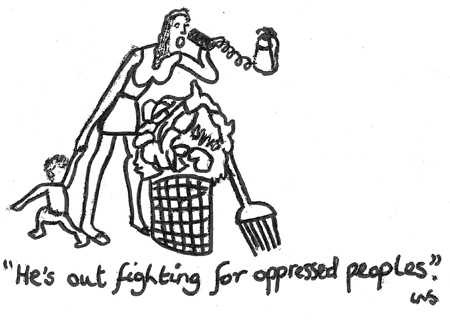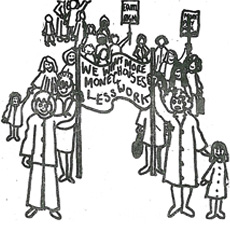Why we did it
We were four women in east London, who came from different backgrounds, but had in common that we were developing our political ideas and practice as feminists and, loosely, socialists. Two of us had been very active as ‘un-supported mothers’ in the Claimants Union, childcare, squatting, and the ‘Libertarian socialist network’. Another was a researcher in social policy. The fourth was training to be a car mechanic with Women in Manual Trades. We wanted to make the link between organising as women around feminist issues, and organising as paid women workers.
Lesneys was the major industrial employer of women in east London, based in Hackney Wick, east London and Rochford, Essex. It produced metal ‘Dinky’ cars, now known as ‘Matchbox’ cars, and collectors’ items. It was like a microcosm of Ford Dagenham, using similar techniques of production and divisions of labour. Women working on the assembly lines ‘finishing’, men working on the more technical machinery.
We wanted to build a women’s group in the Hackney factory, which employed over 6,000 workers – the majority of them women. All working women do two jobs. The Dagenham women workers had recently waged a strike for Equal Pay, and we thought it would be possible to build on this and develop links between the issues women face in the factory and the issues women face at home – low paid work, and unpaid work at home, sexism and racism. (See Women’s Lives – A Basis for Struggle, which some of us helped write, and the Working Women’s Charter.)
An individual account of why we set up the Lesneys Women’s Group
We were very interested in the ‘politics of autonomous class struggle’ being developed in Italy at the time by theorists such as Toni Negri, but also developed throughout the 60s by the UK organisation ‘Solidarity’. We were influenced by populists of theory such as Potere Operaio, the Italian organisation Lotta Continua, the Situationist International (Vaneigem and Debord), and Selma James and Mariarosa Dalla Costa (see Influences).
My personal experience was of the 1968 student and women’s liberation movement, direct action (occupations, graffiti), squatting, claimants’ union and running crèches. This experience, combined with reading Marx, Luxemburg and Kollontai, put a firmly ‘class’ lens in my eyes and led to my decision to get a job at a local factory that was the largest employer of women in my area, Lesney’s, and subsequently join East London Big Flame. Through contact with Liverpool Big Flame I saw the inter-relationships of struggles happening there: the occupations of the factories like Birds Eye, taking supporters from the occupations onto the housing estates that were on rent strike (Tower Hill in Kirby, Liverpool being the main one and the subject of the 1974 film Behind the Rent Strike) and vice versa, Fords workers and miners and dockers learning about women’s issues. There had been enough contradictions in my family life and upbringing for this all to make sense to me, and see the importance of women working in industry and being members of powerful trade unions being able to develop their own voice and demands – and of course, the Ford women seamstresses strike had only recently been resolved (to their detriment).
What we did
Four of us got jobs there in 1974. We were a women-only group and early on decided that we would produce a ‘Lesneys newsletter’ which would be distributed free at the factory gates. In it, using cartoons, personal stories and news items, we explained the Equal Pay Act and its possibilities and drawbacks; we criticised the male-dominated exclusionary practises of the AUEW ( our trade union), we described a day in an assembly line worker’s life (beginning with getting up to cook the family meal at 2am because of Ramadam, and then going to work a full shift at 6am), we described one of ours’ experience of being sexually attacked when going home from work on a dark winter’s night. We called meetings, but nobody came. We must have been perceived as middle class and ‘different’, and I for one found it impossible to engage in the sexist and racist banter that was the norm. I knew (even though I didn’t acknowledge it to myself at the time) that I didn’t have to be there for the long haul, unlike the other women working there. I remember a woman I worked next to urging me to get out of the factory and get a good education – which I later did, as an architect. We did however recruit one active member from the shop floor, who became active in the women’s liberation movement and trained as a plumber.
The whole experience is described in the pamphlet written at the time, Working at Lesneys.
A picture that stays in my mind: we tried to work with the female convenor who represented the women in the AUEW in the two factories. She was married to the male AUEW convenor, so we didn’t hold out much hope. She was however supportive about disseminating information about the Equal Pay Act. I remember going with a friend to visit her at the beauty salon, after work on a Friday. We were both shocked at the hair do and make-up she was developing for the week-end; but despite our puritan feminist slant, we managed to fathom that maybe this was something a working-class woman would feel had made the week’s drudgery worthwhile. On the web there are pictures showing Lesneys workers who were fairly stylishly dressed and coiffed, apparently enjoying their jobs (see www.vintagebritishdiecasts.co.uk/factory.htm). This wasn’t typical of my experience, where many of the women looked as if the life blood had been sucked out of them.
Looking back…
Working in that factory for a year profoundly changed my world view. I think for the first time I understood what ‘class’ was really about, and for the first time felt personally angry about it. I also learnt about what we are up against with racism and sexism. Poignant examples: the white women would put air freshener sprays between themselves and black women, if they had to work together on an assembly line (which they would do much to avoid). Pictures show that the white women and the black women were working separately from each other (see www.vintagebritishdiecasts.co.uk/factory.htm). The men in the foundry made one of us climb a ladder carrying a car engine carburettor (weighing similar to a sack of potatoes) to prove she could handle heavy weights as well as a man.
The Lesneys group flared brightly for about a year. We used the experience to try to put forward to the Big Flame conference of 1975 why we considered it crucial for women in the organisation to have autonomy of political decision making (see Working at Lesneys pamphlet).
